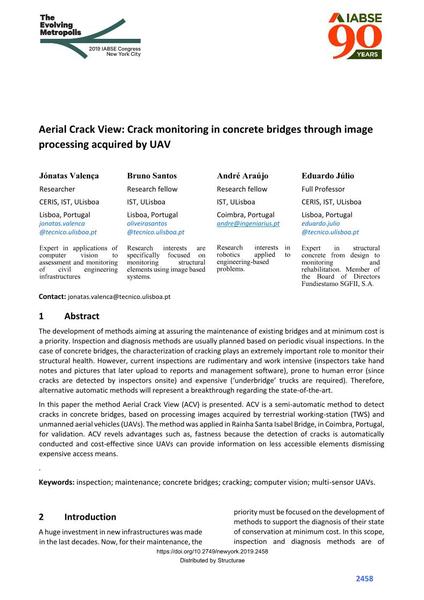Aerial Crack View: Crack monitoring in concrete bridges through image processing acquired by UAV

|
|
|||||||||||
Détails bibliographiques
| Auteur(s): |
Jónatas Valença
Bruno Santos (IST, ULisboa) André Araújo (IST, ULisboa) Eduardo Júlio |
||||
|---|---|---|---|---|---|
| Médium: | papier de conférence | ||||
| Langue(s): | anglais | ||||
| Conférence: | IABSE Congress: The Evolving Metropolis, New York, NY, USA, 4-6 September 2019 | ||||
| Publié dans: | The Evolving Metropolis | ||||
|
|||||
| Page(s): | 2458-2465 | ||||
| Nombre total de pages (du PDF): | 8 | ||||
| DOI: | 10.2749/newyork.2019.2458 | ||||
| Abstrait: |
The development of methods aiming at assuring the maintenance of existing bridges and at minimum cost is a priority. Inspection and diagnosis methods are usually planned based on periodic visual inspections. In the case of concrete bridges, the characterization of cracking plays an extremely important role to monitor their structural health. However, current inspections are rudimentary and work intensive (inspectors take hand notes and pictures that later upload to reports and management software), prone to human error (since cracks are detected by inspectors onsite) and expensive (‘underbridge’ trucks are required). Therefore, alternative automatic methods will represent a breakthrough regarding the state-of-the-art. In this paper the method Aerial Crack View (ACV) is presented. ACV is a semi-automatic method to detect cracks in concrete bridges, based on processing images acquired by terrestrial working-station (TWS) and unmanned aerial vehicles (UAVs). The method was applied in Rainha Santa Isabel Bridge, in Coimbra, Portugal, for validation. ACV revels advantages such as, fastness because the detection of cracks is automatically conducted and cost-effective since UAVs can provide information on less accessible elements dismissing expensive access means. . |
||||
| Mots-clé: |
Pont en béton
|
||||
